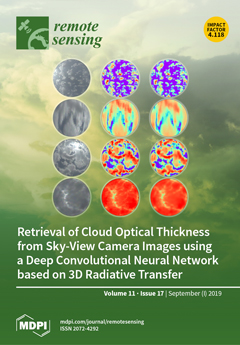We derived an atmospheric motion vector (AMV) algorithm for the Geostationary Korea Multipurpose Satellite (GEO-KOMPSAT-2A; GK-2A) launched on 4 December 2018, using the Advanced Himawari Imager (AHI) onboard Himawari-8, which is very similar to the Advanced Meteorological Imager onboard GK-2A. This study clearly
[...] Read more.
We derived an atmospheric motion vector (AMV) algorithm for the Geostationary Korea Multipurpose Satellite (GEO-KOMPSAT-2A; GK-2A) launched on 4 December 2018, using the Advanced Himawari Imager (AHI) onboard Himawari-8, which is very similar to the Advanced Meteorological Imager onboard GK-2A. This study clearly describes the main steps in our algorithm and optimizes it for the target box size and height assignment methods by comparing AMVs with numerical weather prediction (NWP) and rawinsonde profiles for July 2016 and January 2017. Target box size sensitivity tests were performed from 8 × 8 to 48 × 48 pixels for three infrared channels and from 16 × 16 to 96 × 96 pixels for one visible channel. The results show that the smaller box increases the speed, whereas the larger one slows the speed without quality control. The best target box sizes were found to be 16 × 16 for CH07, 08, and 13, and 48 × 48 pixels for CH03. Height assignment sensitivity tests were performed for several methods, such as the cross-correlation coefficient (CCC), equivalent blackbody temperature (EBBT), infrared/water vapor (IR/WV) intercept, and CO
2 slicing methods for a cloudy target as well as normalized total contribution (NTC) and normalized total cumulative contribution (NTCC) for a clear-air target. For a cloudy target, the CCC method is influenced by the quality of the cloud’s top pressure. Better results were found when using EBBT and IR/WV intercept methods together rather than individually. Furthermore, CO
2 slicing had the best statistics. For a clear-air target, the combined use of NTC and NTCC had the best statistics. Additionally, the mean vector difference, root-mean-square (RMS) vector difference, bias, and RMS error (RMSE) between GK-2A AMVs and NWP or rawinsonde were smaller by approximately 18.2% on average than in the case of the Communication, Ocean and Meteorology Satellite (COMS) AMVs. In addition, we verified the similarity between GK-2A and Meteosat Third Generation (MTG) AMVs using the AHI of Himawari-8 from 21 July 2016. This similarity can provide evidence that the GK-2A algorithm works properly because the GK-2A AMV algorithm borrows many methods of the MTG AMV algorithm for geostationary data and inversion layer corrections. The Pearson correlation coefficients in the speed, direction, and height of the prescribed GK-2A and MTG AMVs were larger than 0.97, and the corresponding bias/RMSE were0.07/2.19 m/s, 0.21/14.8°, and 2.61/62.9 hPa, respectively, considering common quality indicator with forecast (CQIF) > 80.
Full article





